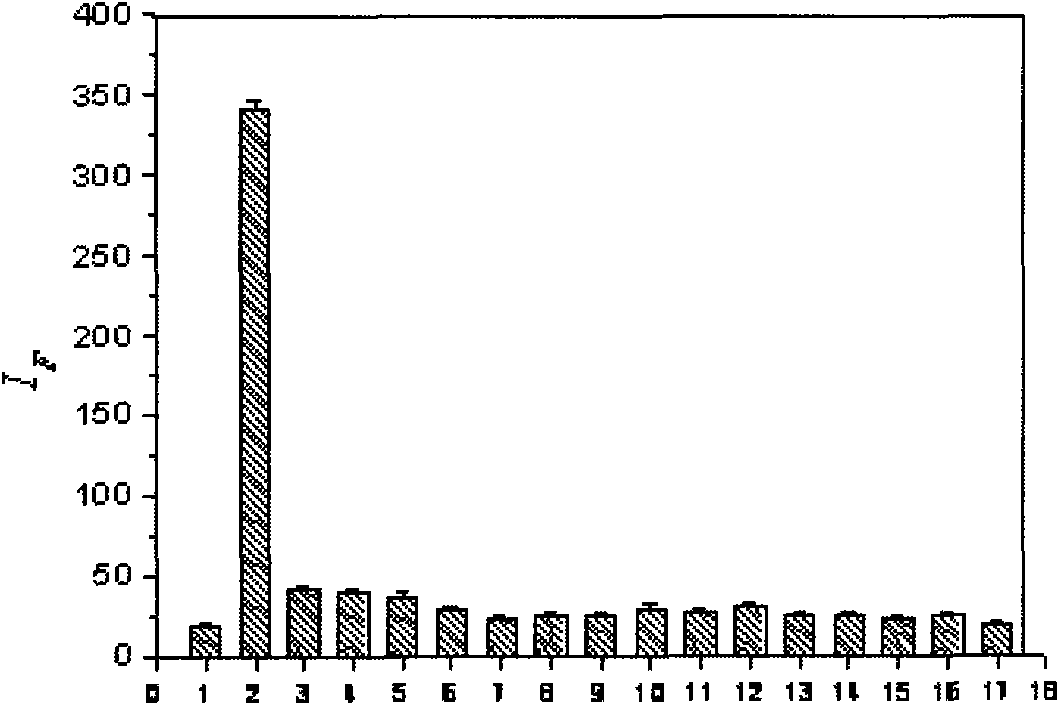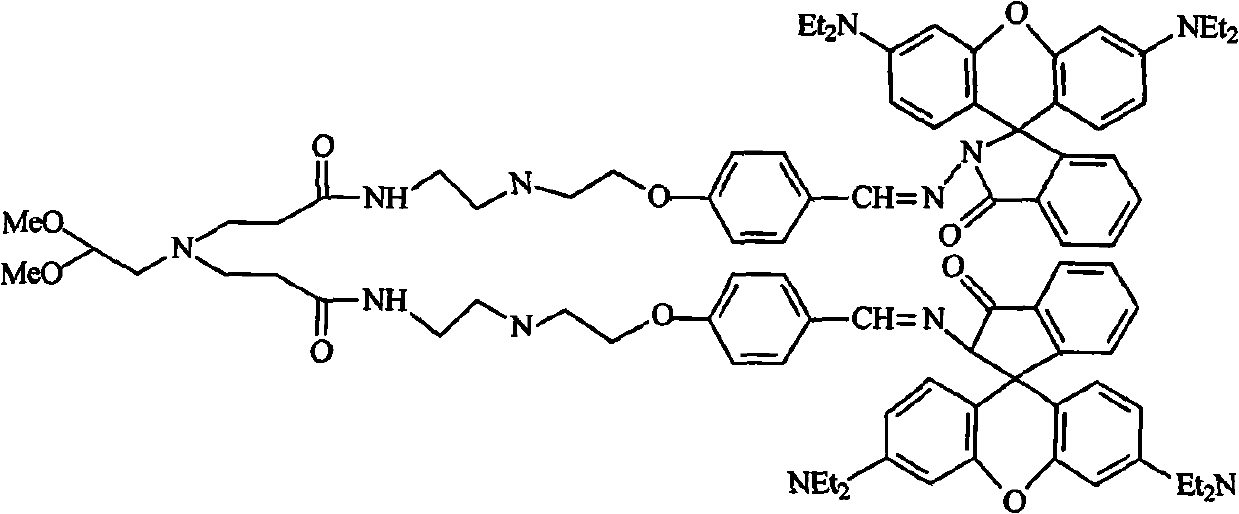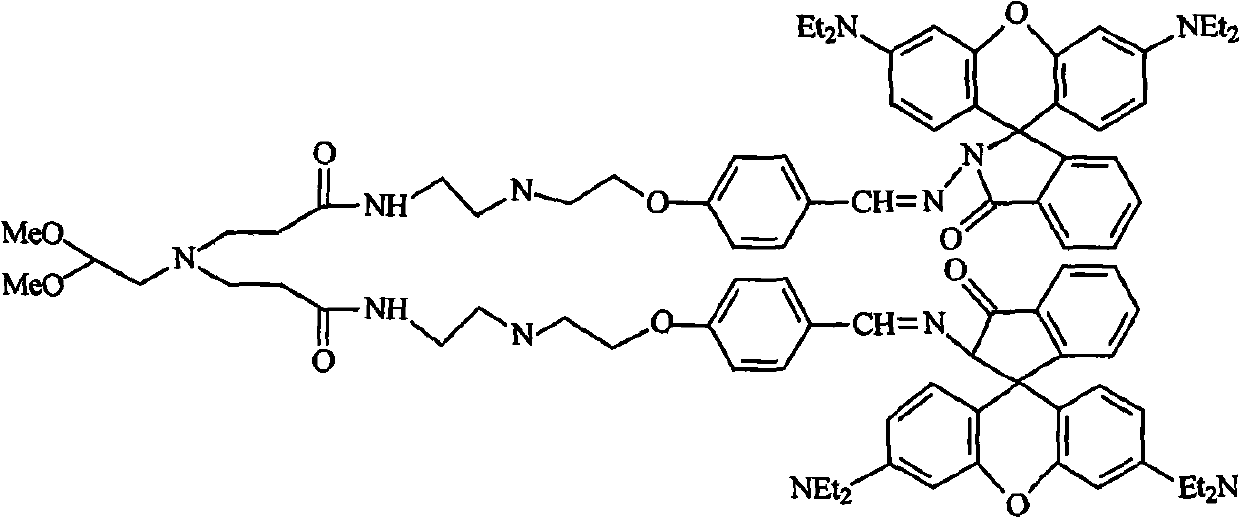Method for manufacturing novel dendritic fluorescent chemosensor and application
A chemical sensor and dendritic technology, applied in the field of analysis and testing, can solve the problems of high price of synthetic raw materials, unsatisfactory sensitivity, complicated post-reaction processing, etc., and achieve the effects of good fluorescence characteristics, simple synthesis method and good stability.
- Summary
- Abstract
- Description
- Claims
- Application Information
AI Technical Summary
Problems solved by technology
Method used
Image
Examples
Embodiment 1
[0023] (1) Synthesis of rhodamine B hydrazide (RBH): 1.2 g of rhodamine B was added to a 100 mL round bottom flask, and completely dissolved in 30 mL of absolute ethanol. Pipette 3.0 mL of 85% hydrazine hydrate, add it dropwise into a round bottom flask, and vibrate vigorously at room temperature. The mixture was heated and stirred at reflux for 2h. The solvent ethanol was evaporated, cooled to room temperature, and allowed to stand for 30 min. Use 50mL 1mol·L -1 HCl was dissolved in the mixture to give a dark red clear solution. Then slowly add about 70mL 1mol·L -1 NaOH, until the pH of the solution is about 7, vibrate, stand still, a brick red precipitate precipitates out, filter under reduced pressure, wash with distilled water several times, and dry to obtain rhodamine B hydrazide. Stored in a desiccator for later use, the yield is 75%.
[0024] (2) Synthesis of Compound 1: Put 3.2g (30mmol) of aminoacetaldehyde dimethyl acetal and 30mL of methanol in a 50mL round bot...
Embodiment 2
[0028] (1) Synthesis of rhodamine B hydrazide (RBH): 1.2 g of rhodamine B was added to a 100 mL round bottom flask, and completely dissolved in 30 mL of absolute ethanol. Pipette 3.0 mL of 85% hydrazine hydrate, add it dropwise into a round bottom flask, and vibrate vigorously at room temperature. The mixture was heated and stirred at reflux for 2h. The solvent ethanol was evaporated, cooled to room temperature, and allowed to stand for 30 min. Use 50mL 1mol·L -1 HCl was dissolved in the mixture to give a dark red clear solution. Then slowly add about 70mL 1mol·L -1 NaOH, until the pH of the solution is about 7, vibrate, stand still, a brick red precipitate precipitates out, filter under reduced pressure, wash with distilled water several times, and dry to obtain rhodamine B hydrazide. Stored in a desiccator for later use, the yield is 75%.
[0029] (2) Synthesis of Compound 1: Put 3.2g (30mmol) of aminoacetaldehyde dimethyl acetal and 30mL of methanol in a 50mL round bot...
Embodiment 3
[0033] Detection method of dendritic fluorescent chemical sensor: sensing Fe 3+ , adopt fluorescence method to detect, and the steps of its specific method are as follows:
[0034] (1) The dendritic fluorescent chemical sensor was made into 1.0×10 ethanol -5 mol L -1 solution; with 0.1mol L -1 Tris hydroxymethyl aminomethane (Tris) solution with an appropriate amount of 0.1mol L -1 The HCl solution was formulated into a buffer solution with a pH of 7.2, and the above two solutions were mixed at a volume ratio of 1:2 to obtain solution A.
[0035] (2) Use a pipette to pipette 3.00 mL of the above solution into a 10 mL colorimetric tube, and add 1 to 10 μg of Fe 3+ Dilute the standard solution with ethanol+water (V / V=1:5) to the mark, shake well, and after standing for 15min, measure the fluorescence intensity at 580nm, the fluorescence intensity varies with Fe 3+ Concentration increases and gradually strengthens.
[0036] (3) Fe in food samples 3+ For the determination o...
PUM
| Property | Measurement | Unit |
|---|---|---|
| recovery rate | aaaaa | aaaaa |
Abstract
Description
Claims
Application Information
 Login to View More
Login to View More - R&D
- Intellectual Property
- Life Sciences
- Materials
- Tech Scout
- Unparalleled Data Quality
- Higher Quality Content
- 60% Fewer Hallucinations
Browse by: Latest US Patents, China's latest patents, Technical Efficacy Thesaurus, Application Domain, Technology Topic, Popular Technical Reports.
© 2025 PatSnap. All rights reserved.Legal|Privacy policy|Modern Slavery Act Transparency Statement|Sitemap|About US| Contact US: help@patsnap.com



